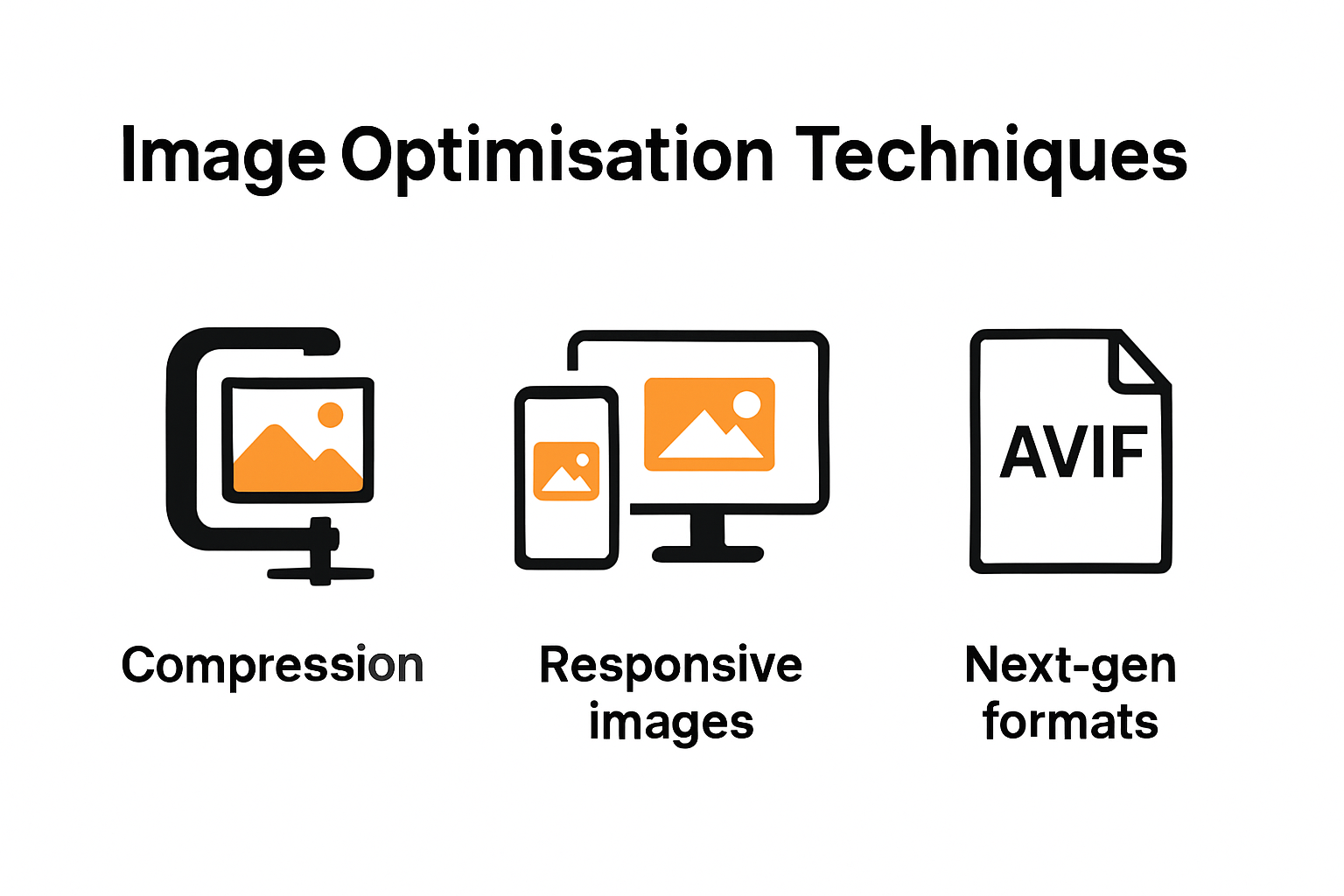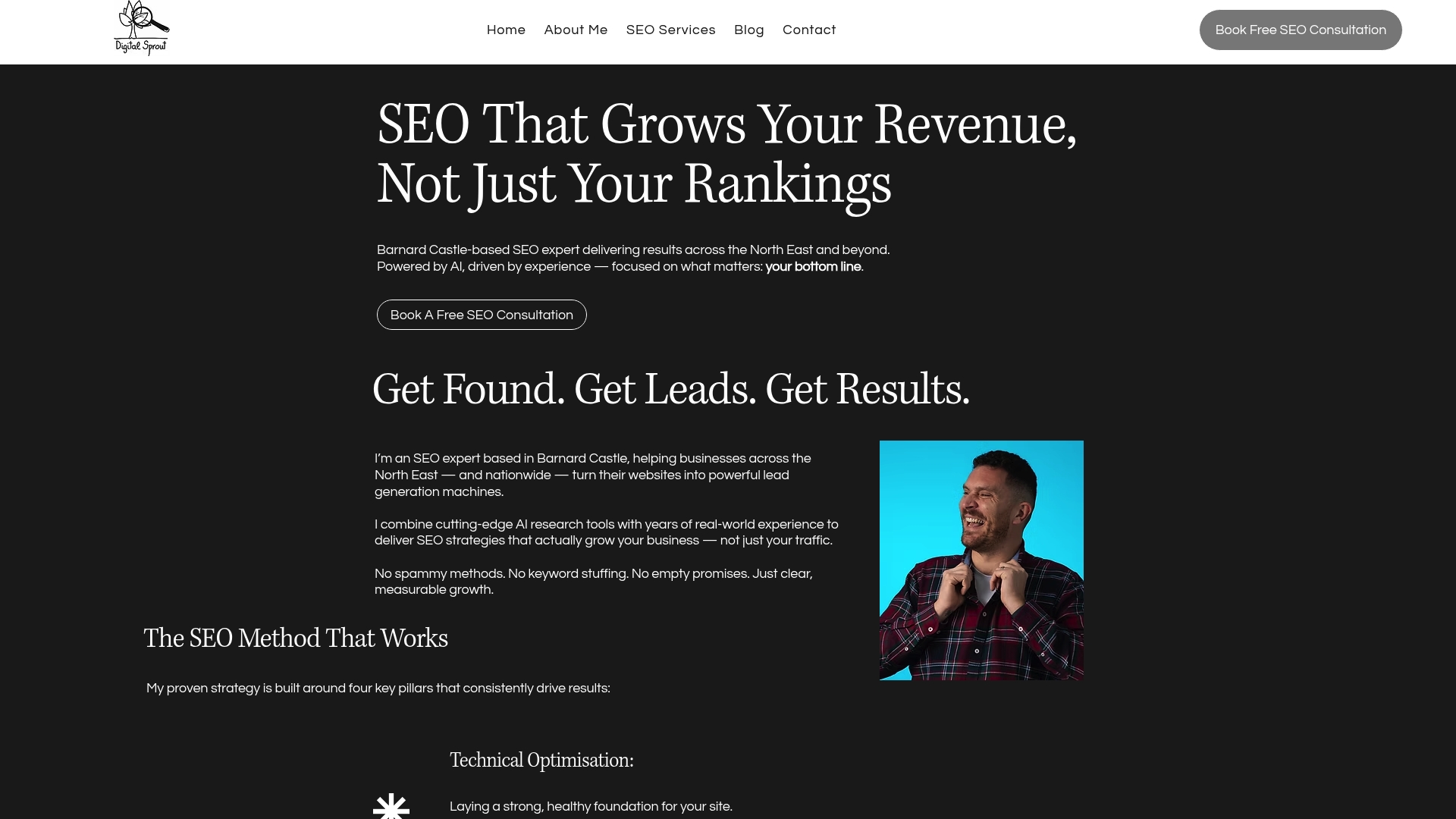Image Optimisation Techniques for Business Growth in 2025
- Mike Dodgson

- Jul 2
- 7 min read
Businesses are pouring resources into sleek visuals and eye-catching web designs, expecting customers to flock in droves. Here is what most miss. Websites with properly optimised images load up to two times faster and see considerably higher conversion rates than those with bloated graphics. A pixel-perfect design means nothing if your images are secretly costing you both traffic and revenue.
Table of Contents
Quick Summary
Why Image Optimisation Matters for Modern Businesses
In the digital ecosystem of 2025, image optimisation has transformed from a technical nicety to a critical business imperative. Companies that understand and implement strategic image optimisation techniques gain substantial competitive advantages across multiple business domains.
Performance and User Experience Impact
Website performance directly correlates with user engagement and conversion rates. Research from Google reveals that websites loading within two seconds experience significantly lower bounce rates compared to slower platforms. Images play a pivotal role in this performance equation.
Unoptimized images can dramatically slow website loading times, creating a frustrating user experience. Large, uncompressed images consume excessive bandwidth, resulting in sluggish page renders that can deter potential customers. By implementing intelligent image optimisation techniques, businesses can:
- Reduce Load Times
: Compress images without sacrificing visual quality
- Improve User Retention
: Create smoother, faster browsing experiences
- Enhance Mobile Accessibility
: Ensure quick loading across diverse devices
Search Engine Visibility and Ranking
Search engines like Google prioritize websites with superior performance and user experience. Research from Moz indicates that page speed is a critical ranking factor, with image optimisation being a key component of this evaluation. Properly optimised images contribute to:

- Faster Crawling
: Search engine bots can more efficiently process well-optimised websites
- Improved SEO Scores
: Better performance signals lead to higher search rankings
- Enhanced User Engagement Metrics
: Faster sites encourage longer visitor interactions
Business Growth and Conversion Potential
Beyond technical metrics, image optimisation directly impacts business growth. Adobe’s digital performance research demonstrates that websites with optimised visual content experience higher conversion rates. Professional imagery that loads quickly builds user trust, communicates brand quality, and supports marketing objectives.
Businesses investing in comprehensive image optimisation strategies can expect tangible benefits: reduced hosting costs, improved user experience, higher search engine rankings, and ultimately, more meaningful customer interactions. In an increasingly competitive digital marketplace, these optimisation techniques are not just recommended—they are essential.
For businesses seeking to understand advanced SEO strategies, exploring comprehensive image optimisation techniques represents a critical pathway to digital success.
Best Tools and Formats for Image Optimisation
In the rapidly evolving digital ecosystem of 2025, selecting the right image optimisation tools and formats can significantly impact a business’s online performance and user experience. Understanding the nuanced landscape of image technologies enables organisations to make strategic decisions that enhance website speed, visual quality, and overall digital effectiveness.
Next Generation Image Formats
The image format landscape has dramatically transformed, with emerging technologies offering superior compression and quality. Google Developers highlights WebP and AVIF as breakthrough formats that provide exceptional compression without sacrificing visual fidelity.
WebP, developed by Google, offers remarkable advantages:
- Smaller File Sizes
: Up to 30% smaller than traditional JPEG images
- High Visual Quality
: Maintains image clarity at significantly reduced file sizes
- Broad Browser Support
: Increasingly adopted across modern web browsers
AVIF (AV1 Image File Format) represents an even more advanced solution. Mozilla Developer Network indicates that AVIF can achieve compression rates 50% more efficient than WebP, making it a compelling choice for businesses prioritizing performance.
Below is a comparison table highlighting the key features and benefits of next generation image formats discussed above.
Recommended Optimisation Tools

Choosing the right optimisation tool can dramatically streamline image processing workflows. Adobe Creative Cloud recommends several professional-grade tools that cater to diverse business needs:
- TinyPNG
: Specializes in intelligent PNG and JPEG compression
- ImageOptim
: Offers advanced compression for multiple image formats
- Squoosh
: A web-based tool providing real-time compression and format conversion
- Cloudinary
: Provides automated image optimization with AI-powered features
For reader convenience, the following summary table organises these recommended tools with their main features:
Strategic Implementation Considerations
Successful image optimisation extends beyond selecting tools and formats. Web Performance Optimization experts recommend a holistic approach that considers responsive design, adaptive serving, and performance metrics.
Businesses should implement:
Responsive image techniques using
and
attributes
Adaptive image serving based on device capabilities
Regular performance audits to validate optimization strategies
By integrating cutting-edge formats and intelligent tools, businesses can significantly enhance their digital presence. Learn more about advanced SEO strategies to complement your image optimisation efforts and drive meaningful online growth.
Step-by-Step Techniques to Improve Website Speed
In the competitive digital marketplace of 2025, website speed represents a critical determinant of business success. Image optimisation plays a fundamental role in enhancing website performance, directly influencing user experience, search engine rankings, and conversion rates.
Image Compression and Preparation Strategies
Research from Google demonstrates that systematic image preparation can dramatically reduce page load times. Businesses must adopt a methodical approach to image compression and selection:
- Select Appropriate Formats
: Prioritize next-generation formats like WebP and AVIF
- Maintain Quality Standards
: Compress images without sacrificing visual clarity
- Choose Correct Resolution
: Match image dimensions precisely to display requirements
Professional image compression tools enable businesses to achieve granular control over file sizes. Techniques like removing metadata, reducing color depth, and applying intelligent compression algorithms can reduce image file sizes by up to 70% without perceptible quality loss.

Responsive Image Implementation
ResearchGate studies reveal that responsive image techniques can reduce unnecessary data transfer by over 70%. Implementing modern HTML attributes like and allows browsers to intelligently select the most appropriate image variant based on device characteristics.
Key responsive image strategies include:
Generating multiple image sizes for different screen resolutions
Using
to provide browser-level image selection
Implementing
attribute to define image display dimensions
Utilizing
element for advanced format and resolution management
Advanced Performance Optimization Techniques
Arxiv research highlights emerging techniques that go beyond traditional compression. Lazy loading represents a sophisticated approach to image performance management. By deferring image loading until they enter the viewport, websites can reduce initial page weight and improve perceived loading speed.
Additional advanced techniques include:
Implementing browser-level lazy loading using
attribute
Using intersection observers for precise image loading control
Leveraging content delivery networks (CDNs) for faster image serving
Embedding critical image data as inline SVGs or low-resolution placeholders
For businesses seeking comprehensive performance optimization, exploring technical SEO fundamentals can provide deeper insights into holistic website performance strategies.
By meticulously applying these step-by-step techniques, businesses can transform their website’s performance, creating faster, more engaging digital experiences that capture and retain user attention in an increasingly competitive online environment.
SEO Best Practices for Effective Image Optimisation
In the intricate digital ecosystem of 2025, image optimisation transcends mere visual appeal and performance metrics. Strategic SEO practices transform images from static elements into powerful conduits for search engine visibility and user engagement.
Metadata and Descriptive Elements
The UK Government Communication Service emphasizes the critical importance of descriptive metadata in image optimization. Businesses must implement comprehensive metadata strategies that communicate image context to both users and search engines.

Key metadata optimization techniques include:
- Precise Alt Text
: Craft descriptive, keyword-relevant alternative text that accurately represents image content
- Meaningful Filenames
: Replace generic file names like “IMG_1234.jpg” with descriptive identifiers such as “marketing-team-strategy-meeting-2025.jpg”
- Strategic Captions
: Provide contextual information that enhances image understanding
Structured Data and Image Indexing
Google’s Search Central Documentation highlights the significance of structured data in improving image discoverability. Implementing schema markup enables search engines to comprehend image relationships and context more effectively.
Advanced structured data strategies encompass:
Embedding image-specific schema markup
Specifying image licensing and copyright information
Providing detailed image object properties
Creating image-specific rich snippets
Accessibility and Technical Optimization
The UK Ministry of Justice Web Guidelines underscores that effective image SEO extends beyond technical configurations to include comprehensive accessibility considerations. Search engines increasingly prioritize websites that deliver inclusive, user-friendly experiences.
Holistic accessibility and technical optimization approaches include:
Ensuring images are screen-reader compatible
Maintaining appropriate color contrast
Implementing responsive image techniques
Verifying cross-device and cross-browser compatibility
Businesses seeking deeper insights into comprehensive digital strategies can explore advanced SEO content optimization techniques to complement their image optimization efforts.
By meticulously integrating these SEO best practices, organizations can transform images from passive visual elements into dynamic, discoverable assets that drive meaningful digital engagement and search engine performance.
Frequently Asked Questions
What is image optimisation and why is it important for businesses?
Image optimisation refers to the process of reducing the file size of images without compromising quality. It is crucial for businesses as it improves website loading speed, enhances user experience, and boosts search engine visibility, leading to higher conversion rates.
How can image optimisation impact website performance?
Properly optimised images can lead to significantly faster loading times, reducing bounce rates and improving user engagement. Optimised images also contribute to better SEO scores, helping websites rank higher on search engines.
What are the best image formats for optimisation?
Next-generation formats like WebP and AVIF are highly recommended for optimisation as they provide superior compression and visual quality. These formats are smaller in size compared to traditional formats like JPEG but maintain high image clarity.
What tools can I use for image optimisation?
Popular tools for image optimisation include TinyPNG, ImageOptim, Squoosh, and Cloudinary. These tools help streamline the compression process, allowing businesses to efficiently manage image quality and improve website speed.
Transform Image Optimisation Into Real Business Growth
Is your website’s slow images wasting hard-earned traffic and putting a brake on conversions? You have seen how unoptimised images can damage website speed, kill user experience and sabotage your chances of ranking in Google. Fast-loading, search-friendly visuals are not just a nice-to-have. They are essential for ambitious brands ready to grow online, as proven throughout this article.
Digital Sprout is helping UK businesses move from frustrated and invisible to fast and discoverable. Our hands-on SEO services bring your entire website up to speed. We fix slow-loading pages, streamline technical SEO, and apply advanced image optimisation so your site commands attention while converting more visitors into leads. If you are ready to leave behind wasted opportunities and make every image work for your bottom line, visit Digital Sprout today. Accelerate your growth while your competitors stand still.
Recommended
- On-page SEO Techniques for Business Growth in 2025
- SEO Content Optimisation 2025: Strategies For Growing Your Business
- How SEO Drives Revenue: Proven Strategies for Business Growth in 2025
- SEO Conversion Optimisation Strategies for Business Growth in 2025
- Conversion Optimisation Basics: A 2025 Guide for Business Growth
- Top SEO Challenges for SMEs in 2025: Tactics for Sustainable Growth
.jpg)